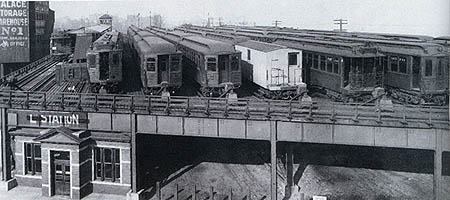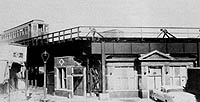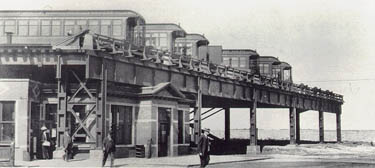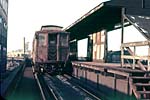
The 42nd Place terminal in
its heyday, circa 1910s. At this time, Kenwood trains were
through-routed to Wilson, meaning more frequent service and
a packed lay-up yard. The brick Greek Revival depot tucked
below the yard is in good repair, still only a few years
old. Like at many terminals, the words "L STATION" are
painted above the entrance to draw attention to the station.
For a larger view, click here.
(Photo from the Collection of George
Krambles)
|
42nd Place
(4232S/1200E)
42nd Place and Oakenwald
Avenue, Kenwood
Service
Notes:

|
Kenwood
Line
|
Quick Facts:
Address: TBD
Established: September 20, 1907
Original Line: South Side Elevated, Kenwood branch
Skip-Stop Type: n/a
Rebuilt: n/a
Status: Demolished
History:

The 42nd Place terminal in
1955, just a few years before its abandonment. By this time
ridership was so low that the main part of the station was
boarded and unused, with passengers routed through a side
entrance instead. Most of the yard tracks are unused. An
Indiana-Kenwood local shuttle waits above at the island
platform. For a larger view, click here.
(Photo from the Collection of George
Krambles)
|
The 42nd Place station was the terminal of the Kenwood branch, a
line built in 1907 by the South Side Rapid Transit line, replacing a
grade-level steam line run by Chicago Junction Railway Company. The
terminal included a compact yard above the station. The area
surrounding the station when rather empty when it opened, but within
a matter of years, it was a bustling residential neighborhood, first
consisting up upscale housing and later dominated by working class
apartments (including many Stock Yards workers).
The station was small and simple, constructed of red brick with
light brick highlights and was tucked under the elevated trestle. Its
architecture is similar to those at Racine
on the Englewood and 69th on the Normal Park
Line, possibly indicating the same architect. Interestingly enough,
the track above and near the station was the only section built on a
steel structure; most was built on a concrete embankment, which was
unusual for the "L". Routes run to the Kenwood branch varied
throughout the years, including Kenwood-Ravenswood runs (1913-1931),
Kenwood-Wilson Avenue rush hour runs and Kenwood-Indiana Avenue non
rush shuttles (1931-1943) and finally Kenwood-Wilson Avenue runs
(1943-1949), until July 31, 1949 when the CTA revised the North-South
service pattern, creating the Kenwood-Indiana
Avenue shuttle.
By 1956, it was clear that the Kenwood branch's dropping ridership
and deteriorating condition warranted action. This situation was
exasperated when the Chicago Junction Railway (which still owned the
right-of-way along which the Kenwood branch was located) demanded
that the CTA resume rental payments which the CRT had ceased during
the Depression. They demanded $100,000 yearly from the CTA and gave
them only until May 1, 1956 to agree, yet CTA's operating loses on
the line had been $200,000 a year! A minimal station improvement
program was contemplated at a cost of up to $46,600 that included
removal of the 42nd Place Yard, the north end of the station's island
platform, the east station track, and possibly even the station
house, leaving only a short platform and one stub track. Mayor Daley
attempted to step in and mediate between the CTA and the CJR,
hammering out an agreement that allowed CTA to continue service for a
token rent of $1,000 per month until July 1957, by which time it was
hoped a final agreement could be negotiated. Ultimately the low
ridership, high cost of improvement and unreasonable rent payments
caused the station to close in 1957 when the line ceased
operation.
|

|
Left: 42nd Place in
early 1908. Lake Michigan is in the background. The
attractive neighborhood station house (though currently
lacking a neighborhood) is tucked beneath the compact but
adequate train yard. (Photo from
the Leroy Blommaert Collection)
|


|
42ndPlace04.jpg
(111k)
42nd Place terminal in less happy time, near the end of its
life in 1957. By 1956, it was clear that the Kenwood
branch's dropping ridership and deteriorating condition
warranted action, which eventually meant abandonment.
(Photos by Northcutt, from the Illinois
Railway Museum Collection, courtesy of Peter
Vesic)
|






